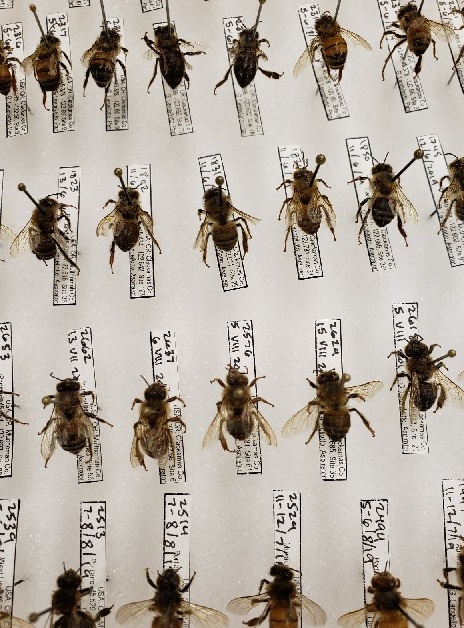Although I have been studying garden bees for the past three years, I was never focused on honey bees. From a biodiversity point of view, they are not very interesting to me. They are non-native and abundant. In fact, honey bees were the most abundant bee species that we collected in Portland-area gardens (332 individuals collected), even though we took great care not to collect more than one individual per visit, when hand-collecting.

Honey bees, which hail from Europe, are only one of 20,000 bee species, worldwide. In North America, there are 4,000 species of bee. In Oregon, we have between 400-500 species of bee. From Portland area gardens, we have documented 86 species of bee (with our 2019 bees still awaiting identification).
Unlike some native bees, honey bees are not at risk of extinction. Compare this to bumblebees. We found 17 species of bumblebee in Portland gardens, two of which (12%) are at risk of endangerment or extinction, due to declining populations: Bombus fervidus and Bombus caliginosus. Across North America, more than 25% of bumblebee species are thought to be at risk of extinction.

Frontal view of Bombus fervidus, a threatened bumblebee species that can be found in Portland area gardens. 
Dorsal view of Bombus fervidus, a threatened bumblebee species that can be found in Portland area gardens.
By focusing ‘save the bee’ campaigns on honey bees, we may be neglecting the bee species that really need our help. In fact, researchers have started to call out organizations and advertising campaigns that promote feel good stories about honey bee conservation as a form of ‘bee washing’. You can visit www.bee-washing.com to learn more about companies that promote their product or organization as being bee-friendly, in a less than genuine way.
Researchers have documented at least seven different ways that honey bees may harm native bee species (summarized in Cane and Tepedino, 2016):
- Honey bees monopolize and deplete nectar and pollen from local plant communities, which can reduce native bee reproduction.
- By depleting local plant resources, native bee females have to devote more time and energy to fly and find new resources, which also reduces native bee reproduction.
- Unlike honey bees, most bees are solitary, which means that they do not live in colonies and they do not have a queen. Solitary females who have access to fewer floral resources produce fewer daughters and more sons. Since female bees are needed to maintain a population, this skewed sex ratio can slow population growth and recovery in native bees.
- When females collect less nectar and pollen, they have less food to feed their young. These bees grow up to be smaller, and are more likely to die over winter, compared to well-fed bees.
- The longer a solitary bee mom is away from her nest, the higher risk that parasites and predators will attack her unguarded young.
- Honey bees can physically block native, solitary bees from preferred pollen hosts.
- Honey bees have many diseases. Some honey bee viruses have been found in native bee communities. Researchers think flowers that are visited by both native bees and honey bees are analogous to an elementary school water fountain: a place where repeat visitors can pick up a pathogen.
Please note that I am not suggesting that you extinguish honey bees from your garden. What I am asking, instead, is that you take the time to learn about and to notice some of the other 80+ species of bee that you might find in your garden. My group is creating a ‘Bees of Portland Gardens’ guide that we hope can help you in this journey. In the meantime, there are some great guides that are currently available. One is Wilson and Carrill’s ‘The Bees in Your Backyard: a guide to North America’s bees’. This book is available at Powell’s City of Books, as well as on Amazon. The second is August Jackson’s ‘The Bees of the Willamette Valley: a comprehensive guide to genera’. This free guide can be found online.
The first step to saving something you love is to be able to recognize it and to call it by name.
References
- Cane and Tepedino. 2016. Gauging the effect of honey bee pollen collection on native bee communities. Conservation Letters 10: 205-210.
- Jackson. 2019. The Bees of the Willamette Valley: A Comprehensive Guide to Genera. Self-Published, Online: https://tinyurl.com/y4qfssrl.
- Wilson and Carrill. 2016. Bees in Your Backyard: A Guide to North America’s Bees. Princeton University Press.





















